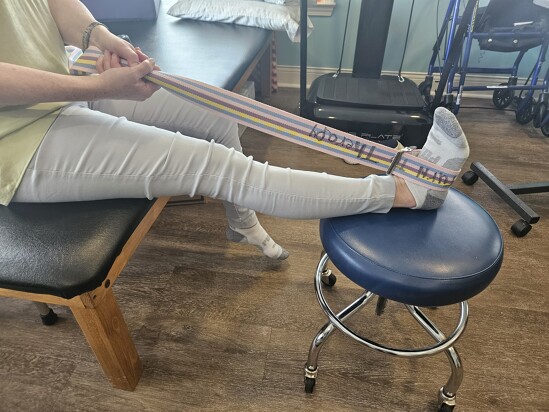How to Manage Spasticity While Sitting in a Chair
Having a diagnosis of multiple sclerosis (MS) may have made you intimately aware of the impact of spasticity on lower extremity muscles. Two of the muscle groups that are affected by spasticity in those with MS are the hip adductors and the gastrocnemius complex or calf musculature. When spasticity increases, discomfort, stiffness and altered functional movement patterns can result.1-3
Benefits of stretching spastic muscles
Stretching spastic muscles while sitting can be beneficial for various reasons:4
- First, if you remain in a static position for much of the day, your muscles may adapt by shortening. Stretching while sitting in intervals throughout the day can prevent that shortening from getting worse.
- Second, if you are upright and sitting, you may have already taken your first daily dose of medication to reduce spasticity, so it is hopefully already working to help assist you.
- Thirdly, I have found that many of my patients with MS literally have “cold feet,” because their legs might be in a dependent position all day with decreased muscle pumping activity to promote blood circulation.
Different stretches
A nice stretch to address inner thigh spasticity can be to place a yoga block or pillow between the knees. I find this helps to maintain the length of the muscles without fighting with your hands to keep your knees apart. Then using the knuckles in a fist to rub the tops of the thighs or the inner thighs can get increased blood flow into the muscle fibers. If you own a vibrating massager or massage gun, you can use it along your thighs for this purpose as well.
A stretch for your calves to perform while sitting could be to put one of your feet on a chair (you could have a caregiver assist with this as well). Using a belt in your closet, you can make a loop, wrap it around your foot, and pull your foot toward your body. If you are doing this correctly, you should feel a tugging sensation in the back of your calf. I tell patients to hold this stretch for up to 2 minutes for maximum benefit. Then return the foot to the floor, place the opposite foot on the chair, and repeat on the opposite side.

Finally, to address any “cold feet” sensation, I tell patients to elevate their legs at intervals throughout the day to help assist with blood flow back to the heart. Another technique that can help to improve circulation if you are sitting a lot can be to use compression stockings.5
But as a caveat, compression stockings can be EXTREMELY hard to get on, and somewhat difficult to get off. If you can use them by yourself or with a caregiver, then fabulous. But if you cannot, intervals of leg elevation throughout the day may suffice. Whatever you do, don’t beat yourself up over what you can or cannot do.
Reducing spasticity
In review, the following techniques are what I recommend to patients to reduce spasticity and maintain mobility in sitting:
- Hip adductor stretching with a pillow or block between the knees
- Ankle stretching with the use of a chair and belt
- Elevating the legs at intervals throughout the day or using compression stockings to maintain good blood circulation
Please feel free to comment below on whether these activities are helpful to you or any modifications that you discovered that came in handy.
Join the conversation